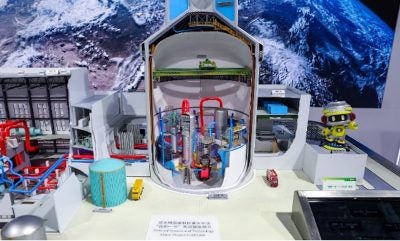
China’s domestic Guohe One nuclear project at Huaneng Group’s Shidaowan site in Rongcheng, Shandong Province, has been connected to the power grid, according to the National Energy Administration (NEA). Unit 1 of the Guohe One nuclear power demonstration project using China’s fully independent intellectual property rights, with independently developed third-generation CAP1400 nuclear technology based on the Westinghouse AP1000, has begun electricity generation, NEA official Dong Wancheng told a press conference.
Guohe One has broken the monopoly of a number of materials and equipment manufacturing technologies, according to a report by the overseas edition of People’s Daily. All key types of equipment and materials such as main pumps, blasting valves, pressure vessels, steam generators and the internal aspects of the reactors were independently designed and manufactured in China, the report said. More than 14,000 intellectual property achievements were made, including more than 2,000 intellectual properties in new products, new materials, new processes, new devices and new software.
There are two units in the first phase of the Guohe One project. Each 1,500 MWe unit has a designed life of 60 years. The annual power generation capacity of the project will be 11.4 TWh which can meet the needs of more than 11 million people and reduce greenhouse gas emissions by more than 9m tonnes a year, according to NEA.
Research and development for Guohe One began in 2008. Some 700 institutions and more than 30,000 technicians participated in the R&D, according to People’s Daily. In December 2009, the State Nuclear Plant Demonstration Company, a joint venture comprising the State Power Investment Corp (SPIC – 55%) and China Huaneng Group (45%) was set up to build and operate the two-unit demonstration project. SPIC officially launched the CAP1400 reactor design in September 2020. Construction of unit 1 started in June 2019 and unit 2 in April 2020.
The CAP1400 design passed the International Atomic Energy Agency’s (IAEA’s) Generic Reactor Safety Review in 2016. However, export of the CAP1400 will still depend on meeting country-specific standards and requirements.
The National Nuclear Safety Administration issued an operating licence for unit 1 in late July this year. The reactor will now undergo gradual power ascension testing and trial operation verification before officially entering commercial operation. According to NEA, since 2022, several CAP series units under SPIC have been approved to start construction, “and this series of nuclear power models will usher in a peak period of construction in the next few years”.
The Shidaowan site also hosts the world’s first fourth-generation reactor plant, the HTR-PM, a high-temperature gas-cooled reactor (HTGR) concept. The HTR-PM demonstration project involves two small 250 MWe HTGRs that drive a single 210 MWe turbine. The site will ultimately host ten 210 MWe units of this type. Construction began in December 2012 and unit 1 achieved criticality in September 2021 followed by unit 2 two months later. Unit 1 was connected to the grid in December 2021 and both units achieved full power in December 2022. The project began commercial operation in December 2023.
The project is owned by a consortium led by China Huaneng (47.5%) with China National Nuclear Corporation’s subsidiary China Nuclear Engineering Corporation (32.5%) and the Institute of Nuclear and New Energy Technologies (INET) of Tsinghua University (20%), which is the head of research and developments.






